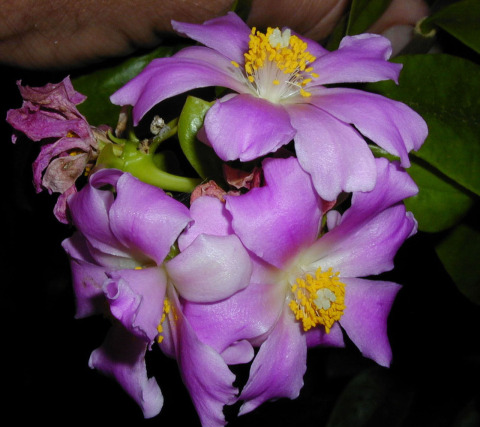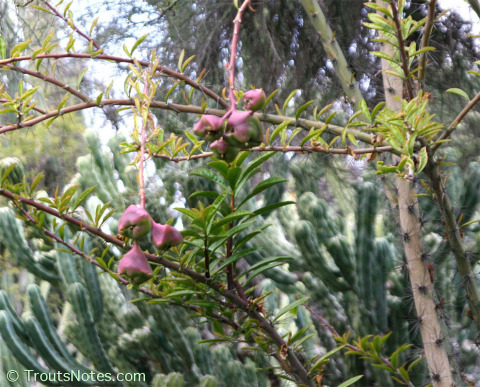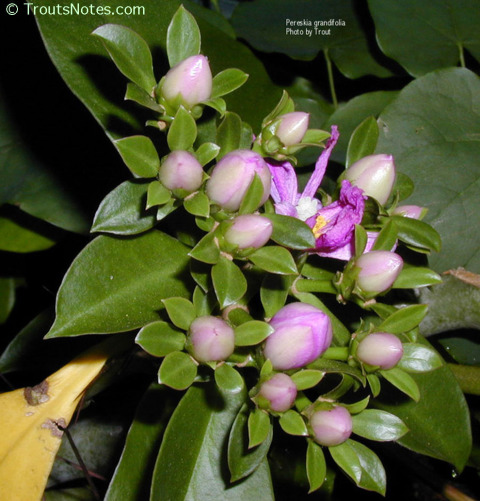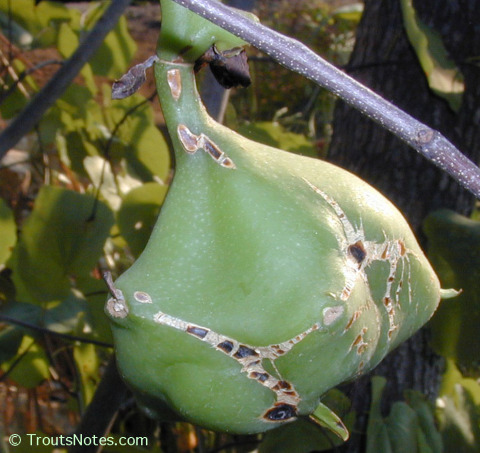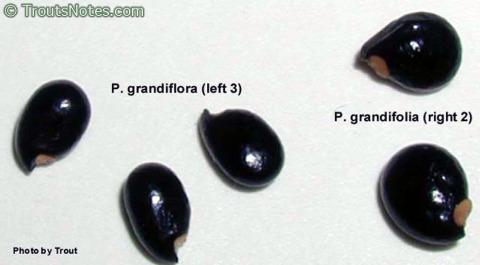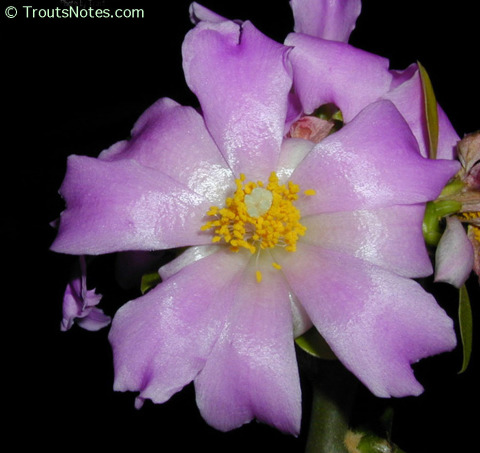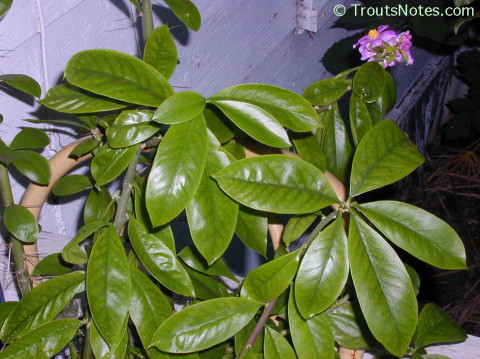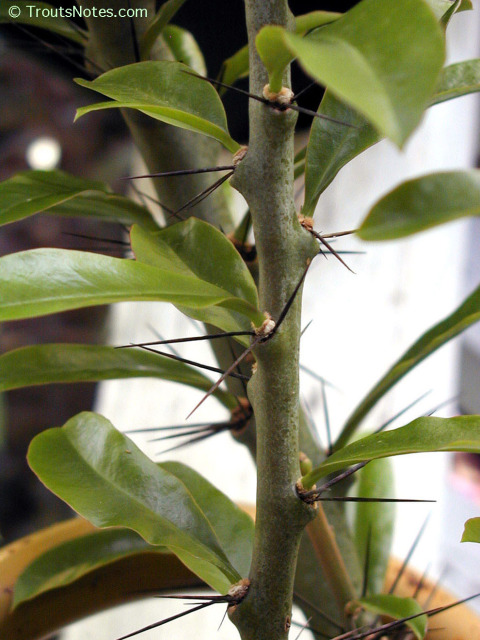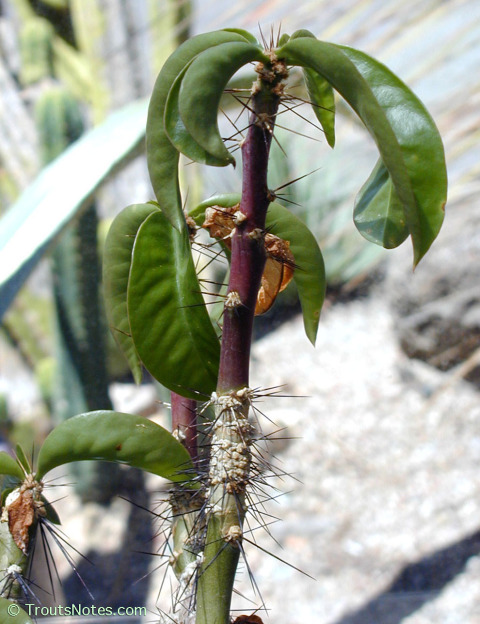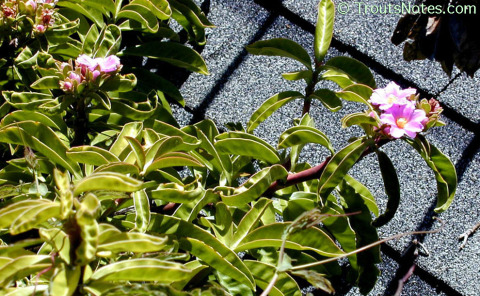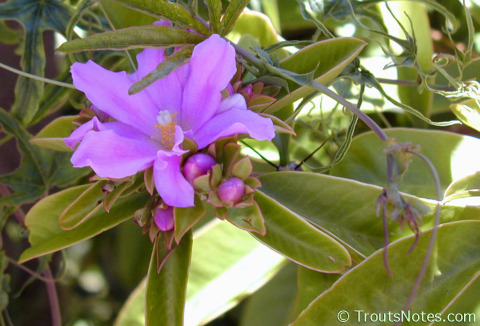The genus Pereskia Mill.
~20 spp. of leafy trees, shrubs and vines occurring through Mexico, West Indies and Central and South America. Some are trunked and upright but many are sprawling.
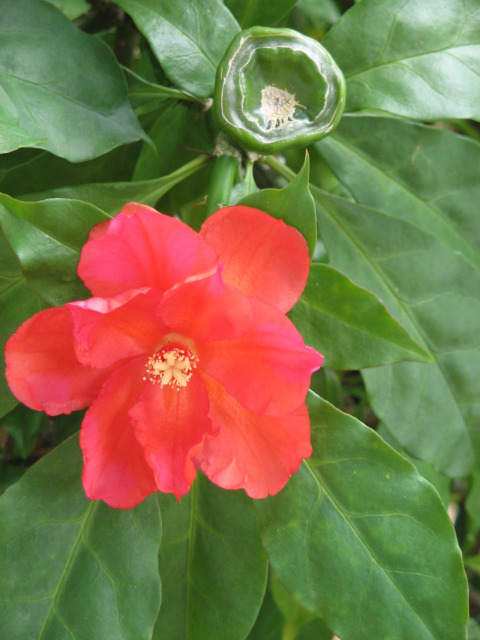
Pereskia bleo
By Meneerke bloem (Own work) [GFDL (http://www.gnu.org/copyleft/fdl.html) or CC BY-SA 3.0 (http://creativecommons.org/licenses/by-sa/3.0)], via Wikimedia Commons
A few species have been in cultivation for many years in warm countries.
Stems are woody and not jointed.
Leaves are alternate, broad and deciduous.
Martin et al. 1971 noted them to only drop their leaves if their temperature in the Fall reaches 40° F. Mine have never exhibited any deciduous behavior in central Texas.
Safford described the glossy leaves as resembling those of lemons.
Areoles spiny but without glochids.
Flowers are stalked solitary or corymbose or panicled, rotate, white or yellow or red. Safford pointed out that the occurrence of clustered or panicled flowers in the Cactaceae is unique to certain species of Pereskia.
Hortus Third: 846
Sometimes more appropriately spelled Peireskia or Peirescia. Named to honor the French naturalist Nicholas Fabre de Peiresc (Nicolaus Claudius Fabricius Peireskius) (1580-1637)]; who Hortus described as being “a French gardener”.
Propagation is by cuttings. Can be raised like a normal cactus but I’ve had better luck treating them like epiphytes. i.e. (similar to orchids but with lower moisture.) Hortus Third: 846
Fruit is said to be apple-shaped (?) and used in the West Indies for sauces and tarts in a manner similar to gooseberries. The seeds are said to be lens shaped and glossy. Safford 1908
See also Backeberg 1958: 104-119 and Britton & Rose 1919; 1:
8-24 and Schuster 1990
Pereskia corrugata Cutak
Ladislaus Cutak (1951) Cactus & Succulent Journal (USA), 23: 173.
Now lumped as a synonym of Pereskia bleo.
Pereskia bleo was published on page 475 in Augustin Pyramus de Candolle (1828) Prodromus Systematis Naturalis Regni Vegetabilis, 3: 457-476. “Cacteae”.
Mescaline is present in trace amounts.
![By കാക്കര (Own work) [CC BY-SA 3.0 (http://creativecommons.org/licenses/by-sa/3.0)], via Wikimedia Commons](https://sacredcacti.com/wp-content/uploads/2015/12/Pereskia-corrugata-ഊട്ടിറോസ്-WikiCommons-480x640.jpg)
Pereskia corrugata
By കാക്കര (Own work) [CC BY-SA 3.0 (http://creativecommons.org/licenses/by-sa/3.0)], via Wikimedia Commons
Common name: As have other Pereskia species, Pereskia corrugata has been called the “Rose cactus”, “Wax rose”. “Leaf cactus”, “Barbados gooseberry”, and “Lemon vine”. Pereskia bleo is perhaps most commonly called “Cactus bleo” or just “Bleo” but has many common names including “Rose cactus”, “Chinese rose”, “Spinach cactus”, “Orange rose cactus” (English), “Bleo de chupa”, “Chupa”, “Chupa melón”, “Najú”, “Najú de culebra” & “Najú de esoubas” (Spanish), “Pokok jarum tujuh bilah” (Malay), “Cak sing cam”, “Qi xing zhen” (Chinese), “Butarrar” (Kuna Indian); (See Zareisedehizadeh et al. 2014.)
Etymology: corrugata is in reference to the wavy leaf margins. bleo means “to flower”, “to bloom” or “a blossom”.
Distribution & occurrence: Of unknown origin. Cutak described P. corrugata based on a specimen in the Missouri Botanical Garden.
“P. Bleo ( H. B. et Kunth nov. gen. amer. 6. p. 69.) foliis oblongis acuminatis, aculeis axillaribus 5-6 fasciculatis, floribus ad apicem ramorum 2-4 breviter pedunculatis, petalis obovatis retusis. 5 in ripâ flum. Magdalenae propè Badillas Novo-Granatensium ubi dicitur Bleo. Flores incarnati. Stam. etiam rubra basi alba. Stigma 5-7-fidum.” p 475 in de Candolle 1828.
as Pereskia corrugata:
Bush or small tree 2.5 meters or taller.
The main trunk is said to have tufts of thin spines.
Stems are grass-green and smooth, later becoming olive-green and shiny.
Spines are sharp, black, of dissimilar lengths, in groups of 3-25 and 5 to 15 mm in length.
Leaves are grass-green, paler underneath and 8-32 cm long and 3-7.5 cm wide.
Backberg 1958: page 118.
Reported analysis (as Pereskia corrugata):
(using tlc and GC)
3,4-Dimethoxyphenethylamine was present in the dry plant at 0.0009%.
Mescaline was present in the dry plant at 0.0005%.
Also observed (with tlc)
3-Methoxytyramine
Tyramine
Doetsch et al. 1980
Pharmacological, chemical and biological review (as Pereskia bleo): Zareisedehizadeh et al. 2014
Pereskia grandifolia Haworth
Ludovico (Ludwig) Haworth (1837) Enumeratio Diagnostica Cactearum Hucusque Cognitarum, 177.
(= Pereskia grandiflora Hort. ex. Pfeiffer)
Mescaline is not present but this species is noteworthy.
Common name: “Rose Cactus” “Blade apple”
Etymology: Grandi- means large. folia is in reference to leaves and flora is in reference to the flowers.
Distribution & occurrence: Brazil. Backeberg also lists occurrence in Mexico, Costa Rica, Cuba, Haiti, Venezuela and Colombia.
Usually cultivated under the name Pereskia bleo according to Backeberg. Compare his opinion with the assorted declarations of synonymity contained herein.
Original description:
“Suppl. p. 85. – Cactus grandifolius LINK enum. 2. p. 25. – REICHENB. fl. exot. 329. – P. grandiflora HORT.
Pa: Brasilia;
P. spinis numerosis variis validis; majoribus biuncialibus nigricantibus, foliis lanceolato-oblongis saturate viridibus, carnosulis, costa subtus valida, deorsum fere in petiblum desinente (HAW.).
P. arborescens, altissima, ramosa; areolis confertis fulvo -tomentosis; aculeis 8–10 brunneis inaequalibus; foliis viridibus, subtus asperis, lanceolatis.
Truncus et rami praecedenti similes. Aculei ½ – 1 poll. longi.
Folia 4 poll. longa, 1½ poll. lata.
Flores verni; ad apices ramorum , subpedunculati, liIaceo-rosei, 1¾ poll. diam. Sepala obscure viridia. Petala basi angusta, sursum latiora, acuminata. Stamina rubra, antheris flavis.” p. 177 in Haworth 1837.
Shrub or tree to 15 feet. Trunk very spiny.
Oblong leaves to 6” with short petioles.
[Black needle-sharp] spines are at first 1-2, to 2 inches long.
Flowers in mostly few flowered terminal clusters, rose-colored or white, 1-1/2 inch across, sepals are green, style and stigma lobes are white.
Hortus Third page 846.
Fruit is pear-shaped with cuneate leaves.
Ed: Perhaps “somewhat pear shaped” would be a better description. Fruit smells wonderful, somewhat like green apples, but tastes bitter, like soap, with a foul after-taste. Seeds are black and very glossy. All fruit remained green when ripe in central Texas and produced very few seeds.
P. grandiflora has thusfar produced seeds for me that were consistently smaller than P. grandifolia but I have examined too few specimens to know if this is a consistent trend.
For a nice microphotograph of a druse crystal observed in a Pereskia grandifolia cell, see page 173 in Mauseth 1983a.
For a photograph of a callusing funiculi; grown in tissue culture, see King 1957, page 104.
Reported analysis:
While both Hortus and Backeberg equate P. grandifolia and P. grandiflora; Doetsch et al. 1980 reported different chemical profiles in their specimens; determining P. grandifolia to contain 3-methoxy-tyramine and 4-methoxy-β-hydroxy-phenethylamine while P. grandiflora was instead found to contain β-Hydroxymescaline.
Tyramine was found in both plants, (as well as in 6 other species of Pereskia.)
Hortus believed material cultivated under the name P. bleo was most likely P. grandifolia, and, further, that P. grandifolia was usually cultivated under the name P. bleo.
Backeberg 1977 gave Pereskia bleo (HBK.) DC. as Rhodocactus bleo (HBK.) Knuth. Also Pereskia grandifolia Haw. as Rhodocactus grandifolius (Haw.) Knuth. [see Backeberg 1958: p. 116; flower, p. 117, fig. 49] Modern workers keep them separated.
Noteworthy also, perhaps, is that all of the mescaline producing Pereskia spp. are considered by Backeberg to be Rhodocacti. Perhaps a hint for future assays?.
Pereskia grandiflora Hort.
Hort. = Hortorum or hortulanorum meaning that it originated as a horticultural offering and that it is not a recognized species.
Mescaline is not present but this plant is noteworthy.
Common name: “Rose Cactus”, “Blade Apple”
Distribution & occurrence: Unknown origin.
This is a widely and popularly cultivated cactus.
Reported chemistry:
β-Hydroxymescaline has been reported
While it is pharmacologically active, it has been reported inactive as a hallucinogen in animal studies. See under its entry in Sacred Cacti Part C, section 1: the Cactus Alkaloids..
Removal of the β-hydroxy group IS readily possible using simple catalytic hydrogenation but that is obviously not a kitchen countertop procedure for untrained people.
Using tlc, Doetsch et al. 1980 observed but curiously did not quantify β-Hydroxy-Mescaline and Tyramine. Strangely, the novel discovery of β-Hydroxymescaline as a natural compound was not explored any deeper.
Normally McLaughlin’s teams are quite anal analytical chemists who are amazingly rigorous about quantitating and proving the identity of never before isolated cactus alkaloids, even if present in tiny traces. Or at least, novel alkaloid discoveries usually merit some interest by their discoverers.
While β-Hydroxymescaline has long been known as a synthetic compound; this single report is its only reported occurrence in nature [Note 41].
Their apparent lack of interest in the occurrence of this molecule in this plant seems puzzling to me.
Pereskia tampicana Weber
Frédéric Albert Constantin Weber (1898) Bulletin du Muséum d’Histoire Naturelle, 4: 167.
Now considered to be lumped as just another synonym of P. grandifolia.
Backeberg 1977 published as Rhodocactus tampicanus (Weber) Backeberg (pg. 406.)
Mescaline is present in trace amounts.
Eytmology: Named for Tampico, Mexico.
Occurrence & distribution: Found in Tampico, Mexico. Said by Safford 1908 to have “…only been collected on the banks of the Rio Panuco, not far from Tampico, in the northern corner of Veracruz.”
This species evidently was later found to have a wider distribution, or perhaps range of cultivation, as the cover of the 1984 CSJA, volume 56, issue #4, features a painting of this species depicting a specimen found growing at Puerto Vallarta, Jalisco, Mexico (near the village of Los Juntos).
Original description (as Pereskia tampicana):
“Tige frutescente, verte, lisse; aréoles convexes, tomenteuses, ordinairement inermes, rarement avec un aiguillon isolé, droit, rouge. Feuilles elliptiques allongées, longues de 7 à 11 8 centimètres, larges de 3 centimetres, rétrécies aux deux bouts, brièvement pétiolées, aiguës an sommet, d’un vert jaunâtre sur les deux faces; nervure médiane de même couleur, saillante sur la face inférieure, marquée par une simple ligne sur la face supérieuse; nervures secondaires peu visibles,
Fleurs disposées en bouquets à l’extrémité des rameaux, longues et larges de 2 à 3 centimètres, d’un rose lilas en forme de coupe. Ovaire piriforme, sub-pédonculé, anguleux, prolifere, verdâtre, garni de quelques squames foliacées inermes, dont 6 à 7 disposées au sammet le l’ovaire ou elles forment une sorte de calicule vert. Sépales 2, pétaloïdes rose lilas clair.
Pétales plus longs, plus colorés, rose lilas pourpre, lancéolés; étamines nombreuses, blanches; anthères jaune soufre, style court, à base conique ; stigmates blancs.
Cette espèce est voisine du Per. grandifolia Haw., du Brésil, dont elle se distingue facilement par ses feuilles beaucoup plus petites et sa tige submerme.” p. 167 in Weber 1898.
See also Backeberg 1958: page 115.
Shrub to 1.5 meters tall. Branches are green and moderately thick.
Areoles have little felt.
Oblong-lanceolate to narrow spatulate leaves are 7-8 cm in length.
Carmine-rose red flowers; 2.5 cm in length and 2-3 cm wide.
Backberg 1958: page 115.
Reported analysis:
Using tlc and GC.
3,4-Dimethoxy-β-phenethylamine was found to be present in the dry plant at 0.0025%.
Mescaline was present at 0.0013% of the dry plant. (1.3 mg per 100 gm of dry plant.)
Also observed (in tlc):
4-Methoxy-β-hydroxy-phenethylamine
β-Phenethylamine
Tyramine
Doetsch et al. 1980
Despite the low values and while it is not clear whether mescaline was actually present in all parts of the plant, it would be worth trying to determine if the deciduous leaves of Pereskia spp. contained mescaline as plants could withstand periodic leaf harvests. Several kilos of dry material is a lot of plant but in tropical or mild temperate zones these plants can get quite large and sprawling with age. They would probably respond very well to thoughtful harvesting, especially if coupled with the rooting of numerous cuttings. These beautiful plants need closer evaluation. [As does the closely related Maihuenia.]
It is not a feasible plant source for any commercial purposes but for an individual or so, in the right climate this subject might prove to be something interesting to study.

